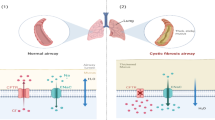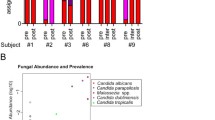Abstract
In many human diseases that cystic fibrosis (CF) patients suffer from, for example, lung infections, bacteria have been considered to grow as biofilms. The ability of key CF pathogens such as Pseudomonas aeruginosa to resist antibiotic therapies may be due to the poor drug penetration of these biofilms. The overall aim of this study was to develop biofilm models in vitro that resembled the bacterial species composition of CF sputa. Here, this was a step towards a longer term goal of forming multiple bacterial biofilm models in vitro that would serve, in turn, as better assays of antibiotic susceptibilities than conventionally grown cells. Biofilm models were constructed from 31 CF sputum samples, using a modified microtitre plate assay. Three forms of assessment of these biofilms were made, namely, the mass, microscopic analysis and species composition. Species composition in sputa and biofilms, characterised by terminal restriction fragment length polymorphism (T-RFLP) analysis of ribosomal gene polymerase chain reaction (PCR) products amplified from directly extracted nucleic acids, indicated that the bacterial community in sputa was well reproduced in the biofilm models. Typically, fresh sputa contained 4.6 ± 2.3 bacterial species, with the species number decreasing to 4.0 ± 1.6 over 5 days—this was not statistically significant (p = 0.29). This study outlines a novel methodology by which to generate and study bacterial biofilms communities. It is also hoped that the versatility of this in vitro approach, combined with its simplicity and high reproducibility, will make it an effective system to study CF sputum biofilm development and, in the longer term, serve as a means of assessing antibiotic susceptibilities.





Similar content being viewed by others
References
Davies JC, Alton EW, Bush A (2007) Cystic fibrosis. BMJ 335:1255–1259
Paschoal IA, de Oliveira Villalba W, Bertuzzo CS, Cerqueira EM, Pereira MC (2007) Cystic fibrosis in adults. Lung 185:81–87
Wagner VE, Iglewski BH (2008) Pseudomonas aeruginosa biofilms in CF infection. Clin Rev Allergy Immunol 35:124–134
Mikkelsen H, Duck Z, Lilley KS, Welch M (2007) Interrelationships between colonies, biofilms, and planktonic cells of Pseudomonas aeruginosa. J Bacteriol 189:2411–2416
Moreau-Marquis S, Stanton BA, O’Toole GA (2008) Pseudomonas aeruginosa biofilm formation in the cystic fibrosis airway. Pulm Pharmacol Ther 21:595–599
Drenkard E (2003) Antimicrobial resistance of Pseudomonas aeruginosa biofilms. Microbes Infect 5:1213–1219
Moskowitz SM, Foster JM, Emerson J, Burns JL (2004) Clinically feasible biofilm susceptibility assay for isolates of Pseudomonas aeruginosa from patients with cystic fibrosis. J Clin Microbiol 42:1915–1922
Aaron SD (2007) Antibiotic synergy testing should not be routine for patients with cystic fibrosis who are infected with multiresistant bacterial organisms. Paediatr Respir Rev 8:256–261
Gilligan PH (2006) Is there value in susceptibility testing of Pseudomonas aeruginosa causing chronic infection in patients with cystic fibrosis? Expert Rev Anti Infect Ther 4:711–715
Rogers GB, Carroll MP, Serisier DJ, Hockey PM, Jones G, Bruce KD (2004) Characterization of bacterial community diversity in cystic fibrosis lung infections by use of 16S ribosomal DNA terminal restriction fragment length polymorphism profiling. J Clin Microbiol 42:5176–5183
Harris JK, De Groote MA, Sagel SD, Zemanick ET, Kapsner R, Penvari C, Kaess H, Deterding RR, Accurso FJ, Pace NR (2007) Molecular identification of bacteria in bronchoalveolar lavage fluid from children with cystic fibrosis. Proc Natl Acad Sci USA 104:20529–20533
Junker LM, Clardy J (2007) High-throughput screens for small-molecule inhibitors of Pseudomonas aeruginosa biofilm development. Antimicrob Agents Chemother 51:3582–3590
Pratten J, Wilson M, Spratt DA (2003) Characterization of in vitro oral bacterial biofilms by traditional and molecular methods. Oral Microbiol Immunol 18:45–49
Filoche SK, Soma KJ, Sissons CH (2007) Caries-related plaque microcosm biofilms developed in microplates. Oral Microbiol Immunol 22:73–79
Goss CH, Burns JL (2007) Exacerbations in cystic fibrosis. 1: Epidemiology and pathogenesis. Thorax 62:360–367
Ceri H, Olson ME, Stremick C, Read RR, Morck D, Buret A (1999) The Calgary Biofilm Device: new technology for rapid determination of antibiotic susceptibilities of bacterial biofilms. J Clin Microbiol 37:1771–1776
Conway SP, Pond MN, Bowler I, Smith DL, Simmonds EJ, Joanes DN, Hambleton G, Hiller EJ, Stableforth DE, Weller P, Littlewood JM (1994) The chest radiograph in cystic fibrosis: a new scoring system compared with the Chrispin–Norman and Brasfield scores. Thorax 49:860–862
Rogers GB, Hart CA, Mason JR, Hughes M, Walshaw MJ, Bruce KD (2003) Bacterial diversity in cases of lung infection in cystic fibrosis patients: 16S ribosomal DNA (rDNA) length heterogeneity PCR and 16S rDNA terminal restriction fragment length polymorphism profiling. J Clin Microbiol 41:3548–3558
Liu WT, Marsh TL, Cheng H, Forney LJ (1997) Characterization of microbial diversity by determining terminal restriction fragment length polymorphisms of genes encoding 16S rRNA. Appl Environ Microbiol 63:4516–4522
Jefferson KK (2004) What drives bacteria to produce a biofilm? FEMS Microbiol Lett 236:163–173
Brogden KA, Guthmiller JM, Taylor CE (2005) Human polymicrobial infections. Lancet 365:253–255
Tarsia P, Aliberti S, Pappalettera M, Blasi F (2007) Mixed community-acquired lower respiratory tract infections. Curr Infect Dis Rep 9:14–20
Andersson S, Kuttuva Rajarao G, Land CJ, Dalhammar G (2008) Biofilm formation and interactions of bacterial strains found in wastewater treatment systems. FEMS Microbiol Lett 283:83–90
Komlos J, Cunningham AB, Camper AK, Sharp RR (2005) Interaction of Klebsiella oxytoca and Burkholderia cepacia in dual-species batch cultures and biofilms as a function of growth rate and substrate concentration. Microb Ecol 49:114–125
Simões LC, Simões M, Vieira MJ (2007) Biofilm interactions between distinct bacterial genera isolated from drinking water. Appl Environ Microbiol 73:6192–6200
Neut D, Hendriks JG, van Horn JR, van der Mei HC, Busscher HJ (2005) Pseudomonas aeruginosa biofilm formation and slime excretion on antibiotic-loaded bone cement. Acta Orthop 76:109–114
Klausen M, Gjermansen M, Kreft JU, Tolker-Nielsen T (2006) Dynamics of development and dispersal in sessile microbial communities: examples from Pseudomonas aeruginosa and Pseudomonas putida model biofilms. FEMS Microbiol Lett 261:1–11
Dowd SE, Sun Y, Secor PR, Rhoads DD, Wolcott BM, James GA, Wolcott RD (2008) Survey of bacterial diversity in chronic wounds using pyrosequencing, DGGE, and full ribosome shotgun sequencing. BMC Microbiol 8:43
Polz MF, Cavanaugh CM (1998) Bias in template-to-product ratios in multitemplate PCR. Appl Environ Microbiol 64:3724–3730
Rogers GB, Carroll MP, Serisier DJ, Hockey PM, Kehagia V, Jones GR, Bruce KD (2005) Bacterial activity in cystic fibrosis lung infections. Respir Res 6:49
Palmer KL, Mashburn LM, Singh PK, Whiteley M (2005) Cystic fibrosis sputum supports growth and cues key aspects of Pseudomonas aeruginosa physiology. J Bacteriol 187:5267–5277
Yoon SS, Coakley R, Lau GW, Lymar SV, Gaston B, Karabulut AC, Hennigan RF, Hwang SH, Buettner G, Schurr MJ, Mortensen JE, Burns JL, Speert D, Boucher RC, Hassett DJ (2006) Anaerobic killing of mucoid Pseudomonas aeruginosa by acidified nitrite derivatives under cystic fibrosis airway conditions. J Clin Invest 116:436–446
Chalmers NI, Palmer RJ Jr, Cisar JO, Kolenbrander PE (2008) Characterization of a Streptococcus sp.-Veillonella sp. community micromanipulated from dental plaque. J Bacteriol 190:8145–8154
Davis JM, Whipp MJ, Ashhurst-Smith C, DeBoer JC, Peel MM (2004) Mucoid nitrate-negative Moraxella nonliquefaciens from three patients with chronic lung disease. J Clin Microbiol 42(8):3888–3890
Acknowledgements
This work was supported, in part, by the Dorothy Hodgkin Postgraduate Award, the Anna Trust and the Biotechnology and Biological Sciences Research Council (BBSRC), United Kingdom.
Author information
Authors and Affiliations
Corresponding author
Rights and permissions
About this article
Cite this article
Spasenovski, T., Carroll, M.P., Lilley, A.K. et al. Modelling the bacterial communities associated with cystic fibrosis lung infections. Eur J Clin Microbiol Infect Dis 29, 319–328 (2010). https://doi.org/10.1007/s10096-009-0861-y
Received:
Accepted:
Published:
Issue Date:
DOI: https://doi.org/10.1007/s10096-009-0861-y




